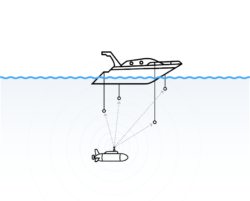Python VS JSON, YAML, CSV & XML
Examples of how to work with JSON, YAML, CSV, and XML files in Python. Today I saw myself preparing some exercises for my student who is learning Python programming language, and...
Filter by Category
Filter by Author

Examples of how to work with JSON, YAML, CSV, and XML files in Python. Today I saw myself preparing some exercises for my student who is learning Python programming language, and...
Posted by Juanmi Taboada

In this post, I describe how my own Arduino Framework for Alioli ROV Submarine Drone works. In my last post about Alioli ROV Submarine Drone, I wrote, “Learn how to Build an...
Posted by Juanmi Taboada

Here is how to make a SIMCOM 7600 module work on an Arduino board (Uno, Mega 2560, Leonardo, Due, Micro, Zero, Nano, Pico), ESP8266, ESP32, Raspberry Pi Pico, MicroPython, or any...
Posted by Juanmi Taboada

I will tell you about my experience repairing a cargo ship as a naval Engineer. Some months ago, you could read in the local newspaper Málaga Hoy that a large cargo ship was...
Posted by Juanmi Taboada

During our operations, very often, we use a Waterlinked Underwater GPS. This helps us to keep track in 3D of our movements and link video recording’s timing and telemetry to...
Posted by Juanmi Taboada

I have experimented very much with photogrammetry and got exciting results. This article talks about this experience. These experiments were done together with Andalú Sea and my...
Posted by Juanmi Taboada

In my last post, “Alioli ROV Boards“, I described most of the hardware I use to build Alioli ROV and how I plan to use it. In this post, I show how the UAV submarine...
Posted by Juanmi Taboada

In my last post, “Get your hardware for Arduino Underwater ROV”, I described most of the hardware I use to build Alioli ROV and how I plan to use it. In this post, I...
Posted by Juanmi Taboada

In my last post, “Finishing the frame for an Underwater ROV”, I gave all details about the design I used to build the frame for Alioli Underwater ROV. In this post, I...
Posted by Juanmi Taboada

In my last post, “How I designed the frame for my Underwater ROV“, I gave all details about the design I used for the frame for Alioli Underwater ROV. In this post, I...
Posted by Juanmi Taboada

Examples of how to work with JSON, YAML, CSV, and XML files in Python.
Today I saw myself preparing some exercises for my student who is learning Python programming language, and last week he asked me about converting a CSV to XML. So I decided to publish these exercises for anybody who doubts how to work with those formats.
Table of Contents
Toggleimport json
example = {
"name": "Kiroga",
"workers": [
{
"name": "Alex",
"sold": 3,
},
{
"name": "Susan",
"sold": 8,
},
{
"name": "Delia",
"sold": 4,
},
]
}
print("=== From Python to JSON String ===")
json_string = json.dumps(example)
print("{} -> {}".format(type(json_string), json_string))
print()
print("=== From JSON String to Python ===")
obj = json.loads(json_string)
print("{} -> {}".format(type(obj), obj))
Result:
=== From Python to JSON String ===
<class 'str'> -> {"name": "Kiroga", "workers": [{"name": "Alex", "sold": 3}, {"name": "Susan", "sold": 8}, {"name": "Delia", "sold": 4}]}
=== From JSON String to Python ===
<class 'dict'> -> {'name': 'Kiroga', 'workers': [{'name': 'Alex', 'sold': 3}, {'name': 'Susan', 'sold': 8}, {'name': 'Delia', 'sold': 4}]}
import yaml
example = {
'incoming data': [
1024,
88,
u'á€eVentura',
192834,
1337,
'no data',
],
'configuration': '/etc/example/config.conf',
'aprox pi value': 3.141592654,
'names': {
'incoming': 'málaga',
'outgoing': 'szczecin',
'days': 4
}
}
print("=== Dictionary to YAML string ===")
yaml_string = yaml.dump(example)
print(yaml_string)
print("")
print("=== YAML string to Dictionary ===")
obj = yaml.safe_load(yaml_string)
print(obj)
Result:
=== Dictionary to YAML string ===
aprox pi value: 3.141592654
configuration: /etc/example/config.conf
incoming data:
- 1024
- 88
- "\xE1\u20ACeVentura"
- 192834
- 1337
- no data
names:
days: 4
incoming: "m\xE1laga"
outgoing: szczecin
=== YAML string to Dictionary ===
{'aprox pi value': 3.141592654, 'configuration': '/etc/example/config.conf', 'incoming data': [1024, 88, 'á€eVentura', 192834, 1337, 'no data'], 'names': {'days': 4, 'incoming': 'málaga', 'outgoing': 'szczecin'}}
import csv
from io import StringIO
example = '''"Origin","Target","Code","Country"
"1.0.0.0","1.0.0.255","AU","Australia"
"1.0.1.0","1.0.3.255","CN","China"
"1.0.4.0","1.0.7.255","AU","Australia"
"1.0.128.0","1.0.255.255","TH","Thailand"'''
print("=== Read as ROW ===")
rows = csv.reader(example.split("\n"), delimiter=',', quotechar='"')
headers = next(rows)
for row in rows:
print("Origin:{:>12s} Target:{:>12s} Code:{:2s} Country:{}".format(*row))
print("")
print("=== Read as Dict ===")
rows = csv.DictReader(example.split("\n"), delimiter=',', quotechar='"')
for row in rows:
print("Origin:{:>12s} Target:{:>12s} Code:{:2s} Country:{}".format(row['Origin'], row['Target'], row['Code'], row['Country']))
print("")
print("=== Write CSV ===")
buffer = StringIO()
header = ['Origin', 'Target', 'Code', 'Country']
writer = csv.DictWriter(buffer, fieldnames=header)
writer.writeheader()
writer.writerow({'Origin': '1.0.0.0', 'Target': '1.0.0.255', 'Code': 'AU', 'Country': 'Australia'})
writer.writerow({'Origin': '1.0.1.0', 'Target': '1.0.3.255', 'Code': 'CN', 'Country': 'China'})
writer.writerow({'Origin': '1.0.4.0', 'Target': '1.0.7.255', 'Code': 'AU', 'Country': 'Australia'})
writer.writerow({'Origin': '1.0.128.0', 'Target': '1.0.255.255', 'Code': 'TH', 'Country': 'Thailand'})
print(buffer.getvalue())
Result:
=== Read as ROW === Origin: 1.0.0.0 Target: 1.0.0.255 Code:AU Country:Australia Origin: 1.0.1.0 Target: 1.0.3.255 Code:CN Country:China Origin: 1.0.4.0 Target: 1.0.7.255 Code:AU Country:Australia Origin: 1.0.128.0 Target: 1.0.255.255 Code:TH Country:Thailand === Read as Dict === Origin: 1.0.0.0 Target: 1.0.0.255 Code:AU Country:Australia Origin: 1.0.1.0 Target: 1.0.3.255 Code:CN Country:China Origin: 1.0.4.0 Target: 1.0.7.255 Code:AU Country:Australia Origin: 1.0.128.0 Target: 1.0.255.255 Code:TH Country:Thailand === Write CSV === Origin,Target,Code,Country 1.0.0.0,1.0.0.255,AU,Australia 1.0.1.0,1.0.3.255,CN,China 1.0.4.0,1.0.7.255,AU,Australia 1.0.128.0,1.0.255.255,TH,Thailand
For me, the resultant source code seems too complex for use, a spaghetti soup code.
from xml.dom import minidom
print("=== Create XML === ")
# Create XML document
root = minidom.Document()
# WMWROOT Element
wmwroot = root.createElement('WMWROOT')
wmwroot.setAttribute('xmlns', 'http://www.manh.com/ILSNET/Interface')
root.appendChild(wmwroot)
# WMWDDATA
wmwdata = root.createElement('WMWDATA')
wmwroot.appendChild(wmwdata)
# WMFWUpload
wmfwupload = root.createElement('WMFWUpload')
wmfwupload.setAttribute('xmlns:xsd', 'http://www.w3.org/2001/XMLSchema')
wmfwupload.setAttribute('xmlns:xsi', 'http://www.w3.org/2001/XMLSchema-instance')
wmwdata.appendChild(wmfwupload)
# Date
node = root.createElement('Date')
node.appendChild(root.createTextNode("2022-09-26T10:36:02.6713225Z"))
wmfwupload.appendChild(node)
# GroupIndex
node = root.createElement('GroupIndex')
node.appendChild(root.createTextNode("1"))
wmfwupload.appendChild(node)
# Id
node = root.createElement('Id')
node.appendChild(root.createTextNode("48fafcd4-f928-4f95-88ca-702ce6139267"))
wmfwupload.appendChild(node)
# ...
node = root.createElement('More')
node.appendChild(root.createTextNode("..."))
wmfwupload.appendChild(node)
# TO String
xml_str = root.toprettyxml(indent="\t")
print(xml_str)
print("")
print("=== Parse XML ===")
xml_obj = minidom.parseString(xml_str)
print("Node {} is Type {}".format(xml_obj.childNodes[0].tagName, type(xml_obj)))
print("NAME:", xml_obj.childNodes[0].childNodes[1].childNodes[1].childNodes[5].tagName)
print("VALUE:", xml_obj.childNodes[0].childNodes[1].childNodes[1].childNodes[5].childNodes[0].data)
print("===================================")
print("Summary:")
print(xml_obj.childNodes)
print(xml_obj.childNodes[0].childNodes)
print(xml_obj.childNodes[0].childNodes[1].childNodes)
print(xml_obj.childNodes[0].childNodes[1].childNodes[1].childNodes)
print(xml_obj.childNodes[0].childNodes[1].childNodes[1].childNodes[5].tagName)
print(xml_obj.childNodes[0].childNodes[1].childNodes[1].childNodes[5].childNodes)
Result:
=== Create XML === <?xml version="1.0" ?> <WMWROOT xmlns="http://www.manh.com/ILSNET/Interface"> <WMWDATA> <WMFWUpload xmlns:xsd="http://www.w3.org/2001/XMLSchema" xmlns:xsi="http://www.w3.org/2001/XMLSchema-instance"> <Date>2022-09-26T10:36:02.6713225Z</Date> <GroupIndex>1</GroupIndex> <Id>48fafcd4-f928-4f95-88ca-702ce6139267</Id> <More>...</More> </WMFWUpload> </WMWDATA> </WMWROOT> === Parse XML === Node WMWROOT is Type <class 'xml.dom.minidom.Document'> NAME: Id VALUE: 48fafcd4-f928-4f95-88ca-702ce6139267 =================================== Summary: [<DOM Element: WMWROOT at 0x7f7f207809b0>] [<DOM Text node "'\n\t'">, <DOM Element: WMWDATA at 0x7f7f20780910>, <DOM Text node "'\n'">] [<DOM Text node "'\n\t\t'">, <DOM Element: WMFWUpload at 0x7f7f20780c30>, <DOM Text node "'\n\t'">] [<DOM Text node "'\n\t\t\t'">, <DOM Element: Date at 0x7f7f20780eb0>, <DOM Text node "'\n\t\t\t'">, <DOM Element: GroupIndex at 0x7f7f207802d0>, <DOM Text node "'\n\t\t\t'">, <DOM Element: Id at 0x7f7f20780190>, <DOM Text node "'\n\t\t\t'">, <DOM Element: More at 0x7f7f20780f50>, <DOM Text node "'\n\t\t'">] Id [<DOM Text node "'48fafcd4-f'...">]
It seems more practical to me when it comes to being used, and the source code is clearer:
import xml.etree.ElementTree as ET
from xml.dom import minidom
print("=== Create XML === ")
# WMWROOT Element
wmwroot = ET.Element("WMWROOT")
wmwroot.set('xmlns', 'http://www.manh.com/ILSNET/Interface')
# WMWDDATA
wmwdata = ET.SubElement(wmwroot, "WMWDATA")
# WMFWUpload
wmfwupload = ET.SubElement(wmwdata, "WMFWUpload")
wmfwupload.set('xmlns:xsd', 'http://www.w3.org/2001/XMLSchema')
wmfwupload.set('xmlns:xsi', 'http://www.w3.org/2001/XMLSchema-instance')
# Date, GroupIndex, Id, ...
node = ET.SubElement(wmfwupload, 'Date').text = "2022-09-26T10:36:02.6713225Z"
node = ET.SubElement(wmfwupload, 'GroupIndex').text = "1"
node = ET.SubElement(wmfwupload, 'Id').text = "48fafcd4-f928-4f95-88ca-702ce6139267"
node = ET.SubElement(wmfwupload, 'More').text = "..."
# TO String
xml_str = ET.tostring(wmwroot)
print(minidom.parseString(xml_str).toprettyxml(indent="\t"))
print("")
print("=== Parse XML ===")
xml_obj = ET.fromstring(xml_str)
print("Node {} is Type {}".format(xml_obj[0].tag, type(xml_obj)))
print("===================================")
print("Summary:")
for wmwdata in xml_obj:
for wmwfupload in wmwdata:
for element in wmwfupload:
print("{} -> {}".format(element.tag, element.text))
Result:
=== Create XML ===
<?xml version="1.0" ?>
<WMWROOT xmlns="http://www.manh.com/ILSNET/Interface">
<WMWDATA>
<WMFWUpload xmlns:xsd="http://www.w3.org/2001/XMLSchema" xmlns:xsi="http://www.w3.org/2001/XMLSchema-instance">
<Date>2022-09-26T10:36:02.6713225Z</Date>
<GroupIndex>1</GroupIndex>
<Id>48fafcd4-f928-4f95-88ca-702ce6139267</Id>
<More>...</More>
</WMFWUpload>
</WMWDATA>
</WMWROOT>
=== Parse XML ===
Node {http://www.manh.com/ILSNET/Interface}WMWDATA is Type <class 'xml.etree.ElementTree.Element'>
===================================
Summary:
{http://www.manh.com/ILSNET/Interface}Date -> 2022-09-26T10:36:02.6713225Z
{http://www.manh.com/ILSNET/Interface}GroupIndex -> 1
{http://www.manh.com/ILSNET/Interface}Id -> 48fafcd4-f928-4f95-88ca-702ce6139267
{http://www.manh.com/ILSNET/Interface}More -> ...
I didn’t manage to work the namespaces in internal nodes.
from lxml import etree as ET
from xml.dom import minidom
print("=== Create XML === ")
# WMWROOT Element
wmwroot = ET.Element("WMWROOT")
wmwroot.set('xmlns', 'http://www.manh.com/ILSNET/Interface')
# WMWDDATA
wmwdata = ET.SubElement(wmwroot, "WMWDATA")
# WMFWUpload
wmfwupload = ET.SubElement(wmwdata, "WMFWUpload")
# NOT WORKING! (Neither with QName)
# wmfwupload.set('xmlns:xsd', 'http://www.w3.org/2001/XMLSchema')
# wmfwupload.set('xmlns:xsi', 'http://www.w3.org/2001/XMLSchema-instance')
# Date, GroupIndex, Id, ...
node = ET.SubElement(wmfwupload, 'Date').text = "2022-09-26T10:36:02.6713225Z"
node = ET.SubElement(wmfwupload, 'GroupIndex').text = "1"
node = ET.SubElement(wmfwupload, 'Id').text = "48fafcd4-f928-4f95-88ca-702ce6139267"
node = ET.SubElement(wmfwupload, 'More').text = "..."
# TO String
xml_str = ET.tostring(wmwroot)
print(minidom.parseString(xml_str).toprettyxml(indent="\t"))
print("")
print("=== Parse XML ===")
xml_obj = minidom.parseString(xml_str)
print("Node {} is Type {}".format(xml_obj.childNodes[0].tagName, type(xml_obj)))
print("NAME:", xml_obj.childNodes[0].childNodes[0].childNodes[0].childNodes[2].tagName)
print("VALUE:", xml_obj.childNodes[0].childNodes[0].childNodes[0].childNodes[2].childNodes[0].data)
print("===================================")
print("Summary:")
print(xml_obj.childNodes)
print(xml_obj.childNodes[0].childNodes)
print(xml_obj.childNodes[0].childNodes[0].childNodes)
print(xml_obj.childNodes[0].childNodes[0].childNodes[0].childNodes)
print(xml_obj.childNodes[0].childNodes[0].childNodes[0].childNodes[2].tagName)
print(xml_obj.childNodes[0].childNodes[0].childNodes[0].childNodes[2].childNodes)
Result:
=== Create XML === <?xml version="1.0" ?> <WMWROOT xmlns="http://www.manh.com/ILSNET/Interface"> <WMWDATA> <WMFWUpload> <Date>2022-09-26T10:36:02.6713225Z</Date> <GroupIndex>1</GroupIndex> <Id>48fafcd4-f928-4f95-88ca-702ce6139267</Id> <More>...</More> </WMFWUpload> </WMWDATA> </WMWROOT> === Parse XML === Node WMWROOT is Type <class 'xml.dom.minidom.Document'> NAME: Id VALUE: 48fafcd4-f928-4f95-88ca-702ce6139267 =================================== Summary: [<DOM Element: WMWROOT at 0x7f7f206fccd0>] [<DOM Text node "'\n\t'">, <DOM Element: WMWDATA at 0x7f7f206fc730>, <DOM Text node "'\n'">] [<DOM Text node "'\n\t\t'">, <DOM Element: WMFWUpload at 0x7f7f206fcd70>, <DOM Text node "'\n\t'">] [<DOM Text node "'\n\t\t\t'">, <DOM Element: Date at 0x7f7f206fcc30>, <DOM Text node "'\n\t\t\t'">, <DOM Element: GroupIndex at 0x7f7f206fceb0>, <DOM Text node "'\n\t\t\t'">, <DOM Element: Id at 0x7f7f206fca50>, <DOM Text node "'\n\t\t\t'">, <DOM Element: More at 0x7f7f206fcb90>, <DOM Text node "'\n\t\t'">] Id [<DOM Text node "'48fafcd4-f'...">]

Finally, Django 1.7 is out, and it is great. Even if it broke some of my oldest Django projects, I love their philosophy. They focus on doing things in the right way. Getting my...

🇬🇧 Read it in English, “GenCreate, GenUpdate, GenDetail and GenDelete“ En el último artículo describíamos Codenerix GenList para comenzar a usar los listados de CODENERIX. Ha...